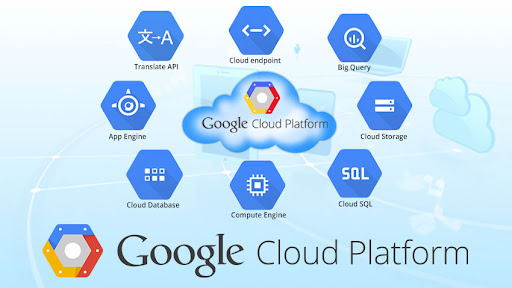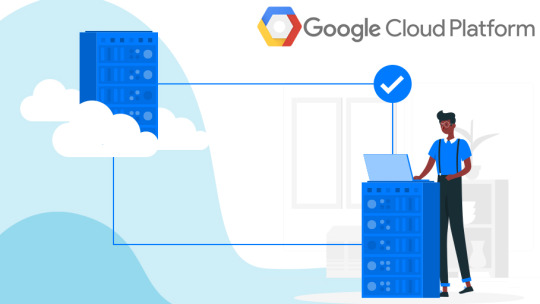#googlecloudservices
Explore tagged Tumblr posts
Text
Trying to choose between AWS, Azure, and Google Cloud? Dive into our detailed comparison of features, pricing, and capabilities to find the ideal cloud platform for your goals.
0 notes
Text
Google Cloud Development Services
Our Google Cloud development services provide businesses with robust cloud solutions to optimize their operations. Key offerings include:

Custom Cloud Solutions: Tailored applications and services that meet your specific business needs.
Cloud Migration: Seamless transition to Google Cloud, ensuring minimal disruption.
Infrastructure Optimization: Enhance performance and scalability with Google Cloud’s advanced tools.
Data Storage & Analytics: Secure and efficient data management with easy-to-use analytics tools.
AI & Machine Learning: Leverage Google’s AI and ML capabilities to drive innovation.
Security & Compliance: Robust security features to safeguard your data and maintain compliance.
With our expertise, we help you fully utilize Google Cloud to improve efficiency, reduce costs, and scale your business with ease. Let us guide your digital transformation journey today.
#GoogleCloud#CloudDevelopment#CloudSolutions#DigitalTransformation#CloudMigration#AI#MachineLearning#Scalability#PerformanceOptimization#CustomCloudSolutions#DataAnalytics#CloudComputing#BusinessGrowth#GoogleCloudServices
0 notes
Text
Galxe Quest Saves With Google Cloud AlloyDB For PostgreSQL

Galxe Quest
The best platform for creating web3 communities is called Galxe Quest. Galxe connects projects with millions of consumers through reward-based loyalty programs while providing a straightforward, no-code solution. Optimism, Arbitrum, Base, and other prominent players in the market trust Galxe as their portal to the largest onchain distribution network on web3.
Create the community of your dreams
Accurate User Acquisition
Turn on autopilot mode for your product marketing and user growth, from on-chain KPIs to off-chain engagements.
Simplified Onboarding of Users
ZK technology is used to encrypt and store your identification data in off-chain vaults so that Galxe never has access to unencrypted data.
More People, Fewer Robots
Your information is private to you alone, and you have complete control over it. As you see appropriate, choose when to provide or deny access to third parties.
Boost Recognition of Your Brand
Your universal web3 identification is Galxe Passport, which removes the need for numerous sign-ups and verifications for various services and apps.
Recognize Faithful Users
Your information is private to you alone, and you have complete control over it. As you see appropriate, choose when to provide or deny access to third parties.
Boost User Retention
Your universal web3 identification is Galxe Passport, which removes the need for numerous sign-ups and verifications for various services and apps.
Plug-and-play, no code solution
Select one of the many Quest templates and easily customize with a few clicks.
Provide Your Own Information
Add your own Google Sheets, CSV files, and API connections to the BYOD (Bring Your Own Data) experience.
Chain-wide Imprint
To automatically track on-chain footprint, connect an API or subgraph.
Twitter Interaction
Keep tabs on interactions like following, liking, retweeting, and attending Twitter Space.
Activities on Discord
Using the Galxe Discord Bot, you can keep tabs on active members, AMA attendees, and Discord roles.
Contributions on GitHub
Recognize the top developers who worked on your product.
Participation in Events
Geo-fenced QR codes facilitate the easy tracking of attendees at both offline and online events.
Status of DAO Voting
With a few clicks, import every voter from your Snapshot.org proposal.
Confirmed People
Your community is shielded from bothersome bots and sybil attacks by using sybil prevention credentials.
Web3 is made of community. Your community and contributors can be encouraged with a range of rewards, such as tokens, loyalty points, reputation, and accomplishments. Learn about other features that Galxe Quest provides.
The next wave of internet development based on blockchain technology is referred to as Web3. It seeks to safeguard self-sovereign identification information, facilitate transactional freedom, decentralize online ownership, and accomplish other goals. Web3, however, is a quickly growing industry with its own set of difficulties. For both developers and end users, there are significant entrance barriers and onboarding friction due to the lack, if not outright absence, of a uniform infrastructure and user experience.
In order to address these current issues, Galxe has created an ecosystem of goods with the goal of bringing the entire planet online. Galxe Quest, the biggest on-chain distribution platform for Web3, is essential to this ecosystem since it links Web3 communities and companies through gamified learn-to-earn opportunities. Galxe Identity Protocol, Google Cloud’s permissionless self-sovereign identity infrastructure, which standardizes the creation, validation, and distribution of on-chain credentials using Zero-Knowledge Proofs, is the foundation upon which this platform is based. Additionally, they introduced Gravity, a Layer-1 blockchain intended for widespread use that eliminates the technical difficulties associated with multichain interactions. This enables developers to leverage Galxe’s 26 million users to produce new Web3 products.
AlloyDB for PostgreSQL earns Google Cloud confidence
Galxe Quest, with more than 26 million active users, requires scalable solutions as well as reliable and substantial data access. A key component in scaling the platform to satisfy the needs of Google expanding user base has been AlloyDB for PostgreSQL.
Because AlloyDB is fully compatible with PostgreSQL and offers high performance for fast online transaction processing (OLTP) workloads, Google Cloud may transition to it with little difficulty and at a reduced cost. After switching to AlloyDB from their previous solution, Amazon Aurora for PostgreSQL, which had much higher costs owing to read and write operations, Google Cloud is able to reduce database expenditures by 40%.
Google Cloud has faith in AlloyDB because of its exceptional performance, almost little downtime, and adaptability. AlloyDB securely stores millions of on-chain and off-chain user data records, serving as their only source of truth. Google Cloud developers may now access detailed datasets to construct blockchain-based loyalty schemes.
Everything we require for faith in Web3
Galxe’s Web3 projects are powered by multiple Google Cloud services. Depending on the requirements of each job, Google Cloud employ Google Kubernetes Engine (GKE) for containerized workloads and AlloyDB and BigQuery for data analysis and storing. Setting up services that continually replicate data from Amazon Aurora to AlloyDB with the goal of minimizing downtime during the transfer was made simple by Google Cloud’s serverless Database transfer Service. Additionally, they used Datastream, a user-friendly change data capture tool that reads and copies AlloyDB data automatically to BigQuery for analysis.
Google Cloud’s network, with its worldwide coverage, low latency, and strong stability offered by premium service tiers, supports Google Cloud’s objective to onboard everyone on the Web 3. With an unmatched user experience, Google Cloud’s consumers worldwide may now easily utilize Galxe’s solutions to explore Web3. Galxe’s architecture also heavily relies on memorystore, which acts as a caching mechanism to manage the substantially higher volume of read operations than write operations in their situations.
Spearheading the upcoming Web3 innovation wave
Galxe collaboration with Google Cloud has yielded several advantages, including improved scalability and stability at a markedly reduced cost. Their ability to grow and support the global Web3 enterprises that are just getting started has shown how important Google Cloud is. Furthermore, AlloyDB’s machine-type scaling and nearly 0% downtime for maintenance windows provide for seamless, uninterrupted service and quick scalability for their clients, allowing them to innovate and expand without hindrance.
Read more on govindhtech.com
#GalxeQuestSaves#GoogleCloud#AlloyDB#PostgreSQL#web3#Snapshot#AmazonAurora#blockchaintechnology#GoogleCloudservices#GitHub#codesolution#GalxeQuest#TECHNOLOGY#TECHNEWS#NEWS#GOVINDHTECH
0 notes
Text
As more organizations plan to migrate from IBM Netezza to GCP and BigQuery, an automated data validation tool can streamline this process while saving valuable time and effort. With our Pelican tool, you can achieve 100% accuracy in data validation – including validation of the entire dataset at every cell level.
As an integral part of our Datametica Birds product suite, Pelican is designed to accelerate the cloud migration process to GCP. Here’s a case study of a leading U.S.-based auto insurance company migrating from Netezza to GCP.
We can help you streamline your cloud migration to GCP. To learn more, contact us now.

#googlecloudsolutions#googlecloudservices#GoogleBigQuery#GCPoverNetezza#migrationofNetezzatotheGoogleCloud Platform#DatameticaBirds
0 notes
Text

#Visualpath provides top-quality #GCPDataEngineering Online Training conducted by real-time experts. Our training is available #worldwide, and we offer daily recordings and presentations for reference. Call us at +91-9989971070 for a free demo.
Telegram: https://t.me/visualpathsoftwarecourses
WhatsApp: https://www.whatsapp.com/catalog/919989971070
Blog Visit: https://gcpdataengineering.blogspot.com/
Visit: https://visualpath.in/gcp-data-engineering-online-traning...
#gcpdataengineer#GoogleCloud#visualpathedu#FreeDemo#onlineclass#gcptraining#googleCloudServices#cloudservices#googlecloudplatform#gcp#dataengineertraining#dataengineer#dataengineeronline#softwaretraining#trendingcourses#dataanalytics#cloudcomputing
0 notes
Photo

Google Cloud Services | Integration Platform
We can help you with seamless integration of Google AI that will make communication. Choose our #googlecloudplatform for your business needs. For more info, click here: https://cloudwaveinc.com/google-cloud-platform/
0 notes
Text
RT @ETTelecom: ETTelecom | Google shuts down cloud project, says no plan to offer cloud services in China #GoogleCloudProject #GoogleCloudInChina #GoogleCloudServices #GoogleCloud #Google #CloudComputing #CloudPlatform #Internet https://t.co/wiGKe2G6IQ
ETTelecom | Google shuts down cloud project, says no plan to offer cloud services in China #GoogleCloudProject #GoogleCloudInChina #GoogleCloudServices #GoogleCloud #Google #CloudComputing #CloudPlatform #Internet https://t.co/wiGKe2G6IQ
— ETTelecom (@ETTelecom) July 9, 2020
via Twitter https://twitter.com/pefid July 10, 2020 at 12:22AM
0 notes
Text
Tweeted
Now #AndroidPhones used to verify sign-ins to #Google and #GoogleCloudServices on #Apple #iPads and #iPhones. ●#technews #technologynews #technologiesnews #techworld #technologyworld #technologiesworld #tech… https://t.co/dI2WeR0ChH
— Tunafo (@TheTunafo) June 13, 2019
0 notes
Text
Catchpoint IPM Now Available On Google Cloud Marketplace

Catchpoint IPM
In most cases, the internet functions remarkably effectively, but what happens if it doesn’t? Since our business depends on flawless access to our applications and services, we demand it at all times. But frequently enough, this anticipation and actuality diverge.
The internet both the public and private IP networks is not a miraculously durable and unfailing network; rather, it is intricate, extremely brittle, dynamic, and prone to outages and service interruptions. Slowdowns, lost data, and operational difficulties are potential outcomes for the Site Reliability Engineers (SREs) who work tirelessly to keep our digital world operational and reachable.
Announcing Google Cloud Marketplace’s Catchpoint IPM
Taking note of these difficulties, Google Cloud is happy to inform you Catchpoint’s line of Internet Performance Monitoring (IPM) products, which are intended to support maintaining the dependability and performance of your digital environment, can now be found on the Google Cloud Marketplace. Through this cooperation, the Google Cloud community can easily use the powerful capabilities of Catchpoint IPM, which offers proactive monitoring of your whole Internet stack, including all of your Google Cloud services.
Take advantage of IPM for unmatched worldwide visibility
It is probable that your applications are distributed regionally, cloud-based, and focused on APIs and services. These days, IPM is essential if you want to have the necessary visibility into all the aspects of the Internet that affect your company, including your workers, networks, websites, apps, and customers.
Gaining insight into everything that may affect an application is essential. This includes user Wi-Fi connectivity, key internet services and protocols like DNS and BGP, as well as your own IP infrastructure, including point-to-point connections, SD-WAN, and SASE. International companies must comprehend the real-world experiences of their clients and staff members, no matter where they may be, and how ISPs, routing, and other factors affect them. What IPM offers is this visibility.
Catchpoint IPM tracks the whole application-user journey, in contrast to traditional Application Performance Management (APM) solutions that focus on the internal application stack. This covers all service delivery channels inside the Google Cloud infrastructure, including computation, API management, data analytics, cloud storage, machine learning, and networking products. It also includes BGP, DNS, CDNs, and ISPs.
With almost 3,000 vantage points across the globe, the largest independent observability network in the world powers Google’s award-winning technology, which lets users monitor from the critical locations for network experts to identify and address problems before they affect the company.
IPM strategies to attain online resilience
By utilizing Catchpoint’s IPM platform available on the Google Cloud Marketplace, you may enhance your monitoring capabilities with an array of potent tools. This is a little peek at what to expect.
Google Cloud Test Suite: Start Google Cloud Monitoring tests with a few clicks
With the help of Google Cloud’s and Catchpoint’s best practices for quick problem identification and resolution, IT teams can quickly create numerous tests for Google Cloud services thanks to the Test Suite for Google Cloud. It is especially user-friendly for beginners because of its design, which minimizes complexity and time investment for efficient Google Cloud service monitoring.
Pre-configured test templates for important Google Cloud services like BigQuery, Spanner, Cloud Storage, and Compute Engine are included in the Test Suite. Because these templates are so easily adaptable, customers can quickly modify the tests to meet their unique needs. This is especially helpful for enterprises that need to monitor and deploy their cloud services quickly.
The Internet Stack Map is revolutionary in guaranteeing the efficiency of your most important apps
With Internet Stack Map, you can see your digital service’s and its dependent services’ current state in real time. For any or all of your important apps or services, you can set up as many as you’d like. Using artificial intelligence (AI), Internet Stack Map will automatically identify all of the external components and dependencies required for the operation of each one of your websites and applications.
Looking across the Internet through backbone connections and core protocols, down to the origin server and its supporting infrastructure, along with any third-party dependencies, external APIs, and other services across the Internet, you can quickly assess the health of your application or service. It is impossible to achieve this distinct, next-generation picture with any other monitoring or observability provider.
Internet Sonar: Provide a response to the query, “Is it me or something else?”
Point of convergence In order to help you avoid occurrences that could negatively effect your experience or productivity, Internet Sonar intelligently offers clear and reliable internet health information at a glance. Internet Sonar monitors from where it matters by using information from the largest independent active observability network in the world. The outcome is a real-time status report driven by AI that can be viewed through an interactive dashboard widget and map, or it can be accessible by any system using an API.
Collaboration between Catchpoint and Google Cloud front end
To further enhance our performance monitoring offerings, Catchpoint has teamed up with Google Cloud to support their front end infrastructure worldwide. Through this partnership, Google Cloud’s global front end and Catchpoint’s Internet Performance Monitoring (IPM) capabilities are combined to give customers more tools for monitoring online performance globally.
Through this cooperation, users will be able to take advantage of Catchpoint’s experience in identifying and resolving performance issues early on, resulting in optimal uptime and service reliability. In addition, Catchpoint is providing professional assistance and a free trial to help gauge and enhance the performance of services that use Google’s global front end.
Read more on govindhtech.com
#CatchpointIPM#GoogleCloud#Marketplace#cloudbased#WiFiconnectivity#APImanagement#GoogleCloudMarketplace#GoogleCloudservices#artificialintelligence#AI#Catchpoint#technology#technews#news#govindhtech
0 notes
Text
youtube
Imagine a workday where AI seamlessly integrates with your tasks, boosting efficiency and creativity. Google Gemini in Workspace makes it a reality!
-Streamline Workflows: Discover how Gemini automates tasks and suggests relevant data and content. -Boost Productivity: Learn how to leverage Gemini for faster email management, smarter document creation, and enhanced data analysis. -Empower Your Team: See how Gemini fosters collaboration and unlocks a new level of productivity for your entire team.
#googlecloudsolutions#googlecloudservices#googlecloudplatform#digitalworkplace#googleworkspace#geminiai#Youtube
0 notes
Text

Visualpath provides top-quality GCP Data Engineer Online Training conducted by real-time experts. Our training is available worldwide, and we offer daily recordings and presentations for reference. Call us at +91-9989971070 for a free demo.
WhatsApp: https://www.whatsapp.com/catalog/919989971070/
Blog Visit: https://gcpdataengineering.blogspot.com/
Visit: https://visualpath.in/gcp-data-engineering-online-traning.html
#gcpdataengineer#googlecloud#visualpathedu#FreeDemo#onlineclass#gcptraining#googleCloudServices#cloudservices#GoogleCloudPlatform#GCP#dataengineertraining#DataEngineer#dataengineeronline#softwaretraining#trendingcourses#dataanalytics#cloud
0 notes
Photo

At CloudWave, We as a partner can help you to unlock the full potential of Google Cloud by customizing and scaling APIs perfectly. For detailed info, click here: https://cloudwaveinc.com/google-cloud-platform/
0 notes
Text
Google Cloud Composer Airflow DAG And Task Concurrency

Google Cloud Composer
One well-liked solution for coordinating data operations is Apache Airflow. Authoring, scheduling, and monitoring pipelines is made possible with Google Cloud’s fully managed workflow orchestration solution, Google Cloud Composer, which is based on Apache Airflow.
Apache Airflow DAG
The subtleties of DAG (Directed Acyclic Graph) and task concurrency can be frightening, despite Airflow’s widespread use and ease of use. This is because an Airflow installation involves several different components and configuration settings. Your data pipelines’ fault-tolerance, scalability, and resource utilisation are all improved by comprehending and putting concurrent methods into practice. The goal of this guide is to cover all the ground on Airflow concurrency at four different levels:
The Composer Environment
Installation of Airflow
DAG
Task
You can see which parameters need to be changed to make sure your Airflow tasks function exactly as you intended by referring to the visualisations in each section. Now let’s get going!
The environment level parameters for Cloud Composer 2
This represents the complete Google Cloud service. The managed infrastructure needed to run Airflow is entirely included, and it also integrates with other Google Cloud services like Cloud Monitoring and Cloud Logging. The DAGs, Tasks, and Airflow installation will inherit the configurations at this level.
Minimum and maximum number of workers
You will define the minimum and maximum numbers of Airflow Workers as well as the Worker size (processor, memory, and storage) while creating a Google Cloud Composer environment. The value of worker_concurrency by default will be set by these configurations.
Concurrency among workers
Usually, a worker with one CPU can manage twelve tasks at once. The default worker concurrency value on Cloud Composer 2 is equivalent to:
A minimal value out of 32, 12 * worker_CPU and 8 * worker_memory in Airflow 2.3.3 and later versions.
Versions of Airflow prior to 2.3.3 have 12 * worker_CPU.
For example:
Small Composer environment:
worker_cpu = 0.5
worker_mem = 2
worker_concurrency = min(32, 12*0.5cpu, 8*2gb) = 6
Medium Composer environment:
worker_cpu = 2
worker_mem = 7.5
worker_concurrency = min(32, 12*2cpu, 8*7.5gb) = 24
Large Composer environment:
worker_cpu = 4
worker_mem = 15
worker_concurrency = min(32, 12*4cpu, 8*15gb) = 32
Autoscaling of workers
Two options are related to concurrency performance and the autoscaling capabilities of your environment:
The bare minimum of Airflow employees
The parameter [celery]worker_concurrency
In order to take up any waiting tasks, Google Cloud Composer keeps an eye on the task queue and creates more workers. When [celery]worker_concurrency is set to a high value, each worker can accept a large number of tasks; hence, in some cases, the queue may never fill and autoscaling may never occur.
Each worker would pick up 100 tasks, for instance, in a Google Cloud Composer setup with two Airflow workers, [celery]worker_concurrency set to 100, and 200 tasks in the queue. This doesn’t start autoscaling and leaves the queue empty. Results may be delayed if certain jobs take a long time to finish since other tasks may have to wait for available worker slots.
Taking a different approach, we can see that Composer’s scaling is based on adding up all of the Queued Tasks and Running Tasks, dividing that total by [celery]worker_concurrency, and then ceiling()ing the result. The target number of workers is ceiling((11+8)/6) = 4 if there are 11 tasks in the Running state and 8 tasks in the Queued state with [celery]worker_concurrency set to 6. The composer aims to reduce the workforce to four employees.
Airflow installation level settings
This is the Google Cloud Composer-managed Airflow installation. It consists of every Airflow component, including the workers, web server, scheduler, DAG processor, and metadata database. If they are not already configured, this level will inherit the Composer level configurations.
Worker concurrency ([celery]): For most use scenarios, Google Cloud Composer‘s default defaults are ideal, but you may want to make unique tweaks based on your environment.
core.parallelism: the most jobs that can be executed simultaneously within an Airflow installation. Infinite parallelism=0 is indicated.
Maximum number of active DAG runs per DAG is indicated by core.max_active_runs_per_dag.
Maximum number of active DAG tasks per DAG is indicated by core.max_active_tasks_per_dag.
Queues
It is possible to specify which Celery queues jobs are sent to when utilising the CeleryExecutor. Since queue is a BaseOperator attribute, any job can be assigned to any queue. The celery -> default_queue section of the airflow.cfg defines the environment’s default queue. This specifies which queue Airflow employees listen to when they start as well as the queue to which jobs are assigned in the absence of a specification.
Airflow Pools
It is possible to restrict the amount of simultaneous execution on any given collection of tasks by using airflow pools. Using the UI (Menu -> Admin -> Pools), you can manage the list of pools by giving each one a name and a number of worker slots. Additionally, you may choose there whether the pool’s computation of occupied slots should take postponed tasks into account.
Configuring the DAG level
The fundamental idea behind Airflow is a DAG, which groups tasks together and arranges them according to linkages and dependencies to specify how they should operate.
max_active_runs: the DAG’s maximum number of active runs. Once this limit is reached, the scheduler will stop creating new active DAG runs. backs to the core.If not configured, max_active_runs_per_dag
max_active_tasks: This is the maximum number of task instances that are permitted to run concurrently throughout all active DAG runs. The value of the environment-level option max_active_tasks_per_dag is assumed if this variable is not defined.
Configuring the task level
Concerning Airflow Tasks
A Task Instance may be in any of the following states:
none: Because its dependencies have not yet been satisfied, the task has not yet been queued for execution.
scheduled: The task should proceed because the scheduler has concluded that its dependencies are satisfied.
queued: An Executor has been given the task, and it is awaiting a worker.
running: A worker (or a local/synchronous executor) is performing the task.
success: There were no mistakes in the task’s completion.
restarting: While the job was operating, an external request was made for it to restart.
failed: A task-related fault prevented it from completing.
skipped: Branching, LatestOnly, or a similar reason led to the job being skipped.
upstream_failed: The Trigger Rule indicates that we needed it, but an upstream task failed.
up_for_retry: The job failed, but there are still retries available, and a new date will be set.
up_for_reschedule: A sensor that is in reschedule mode is the task.
deferred: A trigger has been assigned to complete the task.
removed: Since the run began, the task has disappeared from the DAG.
A task should ideally go from being unplanned to being scheduled, queued, running, and ultimately successful. Unless otherwise indicated, tasks will inherit concurrency configurations established at the DAG or Airflow level. Configurations particular to a task comprise:
Pool: the area where the task will be carried out. Pools can be used to restrict the amount of work that can be done in parallel.
The maximum number of concurrently executing task instances across dag_runs per task is controlled by max_active_tis_per_dag.
Deferrable Triggers and Operators
Even when they are idle, Standard Operators and Sensors occupy a full worker slot. For instance, if you have 100 worker slots available for Task execution and 100 DAGs are waiting on an idle but running Sensor, you will not be able to run any other tasks, even though your entire Airflow cluster is effectively idle.
Deferrable operators can help in this situation.
When an operator is constructed to be deferrable, it can recognise when it needs to wait, suspend itself, free up the worker, and assign the task of resuming to something known as a trigger. Because of this, it is not consuming a worker slot while it is suspended (delayed), which means that your cluster will use a lot fewer resources on inactive Operators and Sensors. It should be noted that delayed tasks do not automatically eat up pool slots; however, you can modify the pool in question to make them do so if desired.
Triggers are short, asynchronous Python code segments that are intended to execute concurrently within a single Python session; their asynchrony allows them to coexist effectively. Here’s a rundown of how this procedure operates:
When a task instance, also known as a running operator, reaches a waiting point, it defers itself using a trigger connected to the event that should resume it. This allows the employee to focus on other tasks.
A triggerer process detects and registers the new Trigger instance within Airflow.
The source task of the trigger gets rescheduled after it fires. The trigger is triggered.
The task is queued by the scheduler to be completed on a worker node.
Sensor Modes
Sensors can operate in two separate modes as they are mostly idle, which allows you to use them more effectively:
Poke (default): Throughout its whole duration, the Sensor occupies a worker slot.
Reschedule: The Sensor sleeps for a predetermined amount of time in between checks, only using a worker slot when it is checking. Part of problem is resolved when Sensors are run in rescheduled mode, which restricts their operation to predetermined intervals. However, this mode is rigid and only permits the use of time as justification for resuming operations.
As an alternative, some sensors let you specify deferrable=True, which transfers tasks to a different Triggerer component and enhances resource efficiency even more.
Distinction between deferrable=True and mode=’reschedule’ in sensors
Sensors in Airflow wait for certain requirements to be satisfied before moving on to downstream operations. When it comes to controlling idle times, sensors have two options: mode=’reschedule’ and deferrable=True. If the condition is not met, the sensor can reschedule itself thanks to the mode=’reschedule’ parameter specific to the BaseSensorOperator in Airflow. In contrast, deferrable=True is a convention used by some operators to indicate that the task can be retried (or deferred), but it is not a built-in parameter or mode in the Airflow. The individual operator implementation may cause variations in the behaviour of the task’s retry.
Read more on govindhtech.com
#GoogleCloud#ComposerAirflowDAG#TaskConcurrency#ApacheAirflow#GoogleCloudservices#CloudMonitoring#CPUcanmanage#processor#cpu#GoogleCloudComposer#technology#technews#news#govindhtech
0 notes
Text
Google Distributed Cloud Air-Gapped Appliance Available Now

Increasing the tactical edge’s access to cloud and AI capabilities: the widely available Google Distributed Cloud air-gapped appliance
Computing capabilities are a major barrier for organisations operating in harsh, disconnected, or mobile locations such as long-haul trucking operations, remote research stations, or disaster zones. Before, enterprises running mission-critical workloads were denied access to crucial cloud and AI capabilities in challenging edge environments environments that come with their own set of requirements and constraints.
Google Distributed Cloud air-gapped appliance
Google is thrilled to announce that the Google Distributed Cloud air-gapped appliance, a new configuration that extends Google’s cloud and AI capabilities to tactical edge locations, is now generally available. Real-time local data processing for AI use cases including object detection, medical imaging analysis, and predictive maintenance for critical infrastructure is made possible by the integrated hardware and software solution. The device can be easily carried in a sturdy case or installed in a rack in local working circumstances according to each customer.
Advanced cloud services, including many of their data and machine learning capabilities, are delivered via Google Distributed Cloud air-gapped. Clients can take advantage of pre-integrated AI technologies, like Speech-to-Text, OCR, and Translation API, which are part of their Vertex AI offering and adhere to Google’s AI Principles. Through marketplace, a catalogue of applications from independent software suppliers (ISVs) is made possible by the solution’s expandable design.
The open cloud strategy of Google Cloud forms the foundation of Google Distributed Cloud. Utilising leading-edge open source components for both the platform and managed services, it is constructed on the Kubernetes API. Because open software uses already-existing knowledge and resources rather than forcing users to pick up new, proprietary systems, it promotes developer adoption more quickly.
The air-gapped appliance from Google Distributed Cloud offers:
Accreditation for Department of Defence (DoD) Impact Level 5 (IL5): The appliance has obtained Impact Level 5 accreditation, which is the strictest security and protection standard needed for sensitive but unclassified data. Additionally, the appliance is actively working towards obtaining these certifications and is designed to fulfil Impact Level 6 and higher accreditations.
Enhanced AI capabilities Customers can use integrated AI features like speech, optical character recognition (OCR), and translation from the Google Distributed Cloud air-gapped appliance to improve the performance of their mission-critical applications. For example, they can scan and translate documents written in many languages using OCR and translation technologies, therefore providing their end users with readable and accessible documents.
Durable and lightweight design the Google Distributed Cloud air-gapped appliance is designed to endure severe environmental conditions, such as high temperatures, shock, and vibration. Its portable and tough design satisfies rigorous accreditation requirements like MIL-STD-810H, guaranteeing dependable performance even in trying circumstances. It is easily transportable and deployable in different locations because to its human-portable weight of roughly 100 pounds.
Complete isolation: The Google Distributed Cloud air-gapped equipment is made to function without a connection to the public internet or Google Cloud. The appliance maintains the security and isolation of the services, infrastructure, and APIs it oversees while operating fully in disconnected settings. Because of this, it is perfect for handling sensitive data while adhering to tight legal, compliance, and sovereignty guidelines.
Integrated cloud services: The Google Distributed Cloud air-gapped appliance provides Google Cloud services including data transfer and analytics technologies in addition to infrastructure-as-a-services (IaaS) elements like computation, networking, and storage.
Data security: To safeguard sensitive data, the Google Distributed Cloud air-gapped appliance has strong security features like firewalls, encryption, and secure boot. For enterprises with strict security needs, the Google Distributed Cloud air-gapped appliance provides a variety of use cases, such as:
Reaction to a disaster: Accurate and timely information is essential for organising relief activities and preserving lives during a disaster. However, the infrastructure required to enable conventional data processing and transmission systems is frequently absent from disaster-affected areas. The Google Distributed Cloud air-gapped appliance is a ruggedized, self-contained device that can be quickly deployed to disaster-affected areas even without internet connectivity.
It has all the necessary software and tools pre-installed for gathering and analysing data, allowing for quick emergency response. Aid organisations may boost their disaster response skills, improve coordination, and save lives during emergencies by utilising the Google Distributed Cloud air-gapped appliance.
Industrial automation: In difficult settings at the edge, the Google Distributed Cloud air-gapped appliance provides a creative solution for remote equipment monitoring, predictive maintenance, and process optimisation. For example, in the manufacturing industry, the device can be used to monitor and optimise the functioning of equipment in remote factories, resulting in increased output and reduced downtime.
Transportation and logistics: The fleet management, autonomous vehicle, and real-time logistics optimisation demands are uniquely supported by the Google Distributed Cloud air-gapped appliance. For instance, by providing real-time data collecting, processing, and decision-making, the device can enable autonomous cars operate and deploy more securely and effectively in difficult environments.
Limited tasks for the government and military: The air-gapped appliance from Google Distributed Cloud is made to support compliance rules and security standards while meeting the needs of limited workloads including AI inference and simulations, intelligence translation, and sensitive data processing.
Michael Roquemore, Director of the Rapid, Agile, Integrated Capabilities Team at the Air Force Rapid Sustainment Office (RSO), stated, “Google Distributed Cloud air-gapped appliance will enable the Air Force to bring the maintenance digital ecosystem to Airmen in austere and forward deployed locations, supporting the Air Force’s agile objectives while prioritising security and reliability.” “The RSO can leverage already developed Google-based technologies in both connected cloud and disconnected edge to bring digital innovation to the Service Members wherever they operate by delivering a secure and compliant edge compute platform.”
Read more on govindhtech.com
#googledistributedcloud#aircapped#aicapabilities#vertexai#googlecloud#kubernetes#apis#gappedapplianc#googlecloudservices#cloudair#ai#cloud#technology#technews#news#govindhtech
0 notes
Text
youtube
Onix, your trusted GenAI partner, offers an on-demand solution that empowers you to:
Access cutting-edge GenAI models without the burden of infrastructure management.
Experiment and innovate with ease, thanks to our flexible and scalable offering.
Focus on core business activities while we handle the technical complexities.
Onix's GenAI On-Demand is the perfect solution for businesses of all sizes looking to:
Generate creative content such as marketing copy, product descriptions, and code.
Personalize customer experiences at scale.
Automate repetitive tasks and boost efficiency.
Join the GenAI revolution. Get started with Onix, a leading Google Cloud Premier Partner, today!
#googlecloudsolutions#googlecloudplatform#cloudsolutions#googlecloudservices#googlecloudpartners#googleworkspace#googlecloudpremierpartner#googlecloud#Youtube
0 notes
Text

#Visualpath provides top-quality #gcpdataengineer Online Training conducted by real-time experts. Our training is available #worldwide, and we offer daily recordings and presentations for reference. Enroll with us for a free demo call us at +91-9989971070
Telegram: https://t.me/visualpathsoftwarecourses
WhatsApp: https://www.whatsapp.com/catalog/919989971070
Visit: https://visualpath.in/gcp-data-engineering-online-traning.html
#gcpdataengineer#GoogleCloud#visualpathedu#FreeDemo#onlineclass#gcptraining#googleCloudServices#cloudservices#googlecloudplatform#gcp#dataengineertraining#dataengineer#dataengineeronline#softwaretraining#trendingcourses#dataanalytics#cloudcomputing
1 note
·
View note